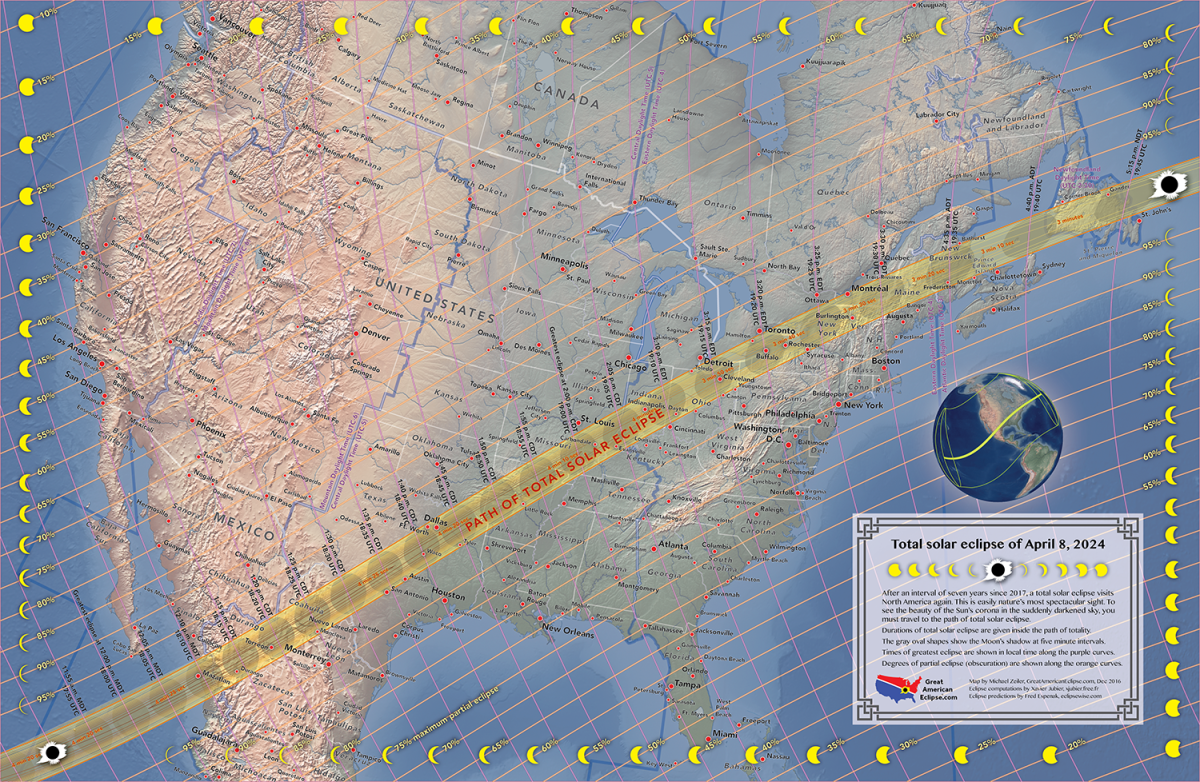Imagine that you live in Dallas, Texas. You are on a peaceful morning walk on April 8, 2024. A breeze blows by, the birds are chirping and the sun hangs high in the sky. No clouds block your view of the vast blue sky. Out of the blue (pun intended), your surroundings begin to darken. Your eyes widen and you glance up, expecting to see an airplane or maybe a large cloud hovering above you. Ouch! You squeeze your eyes shut and look down to the ground. What did you just see that almost blinded you?
A total solar eclipse will occur on April 8, 2024, and its path of totality passes through North America. What is a total solar eclipse? What is the “path of totality”? April 8, 2024? That is in 7 months. Why talk about it now? If solar eclipses interest you, this is a good opportunity to view one in-person.
Solar eclipses occur when the sun, moon, and earth are aligned, and the moon passes between the sun and the earth. Because of this alignment, the moon casts a shadow onto earth, which has two parts– the umbra and the penumbra. The umbra is the inside part of the shadow, which is also the darkest. Viewers in this area will be able to see a full eclipse. The penumbra is the outside part of the shadow and is not as dark, because some light will still be visible. Viewers in this area will only see a partial eclipse.
What is so special about the word “total”? There are four types of solar eclipses– total, annular, partial, and hybrid. Total solar eclipses are when the moon seemingly covers the entire visible surface of the sun. Only the corona of the sun is visible. “We can’t normally see the corona – the Sun’s outer atmosphere – because the Sun’s surface below it is so much brighter. But during a total solar eclipse, the corona becomes visible, offering unique opportunities to study it” (Solarsystem.nasa.gov). Total eclipses differ from annular solar eclipses and partial eclipses where the moon only blocks a portion of the sun. “After the total solar eclipse on April 8, 2024, the next solar eclipse that can be seen from the contiguous United States will be on Aug. 23, 2044” (Solarsystem.nasa.gov). If you miss this one, it might be a twenty year wait!
What places will cross with the path of totality in the contiguous United States? It will pass through the states of Texas, Oklahoma, Arkansas, Missouri, Kentucky, Illinois, Indiana, Ohio, Pennsylvania, New York, Vermont, New Hampshire, and Maine (Greatamericaneclipse.com). Sadly, it will not cross over J.W. North. If we were to view it from J.W. North, we would only see the moon cover around 50% of the sun and would not be able to see the corona.
How should one view a solar eclipse? Do not view a solar eclipse without eye protection. Sunglasses, no matter how dark, cannot protect the eye from the brightness of the sun. “Safe solar viewers are thousands of times darker and must comply with the ISO 12312-2 international standard” (Solarsystem.nasa.gov). Never look into a camera, binoculars, or telescope lens without the proper special-purpose solar filter. If done so, the eyes can be severely injured. Only when the solar eclipse reaches totality can eye protection be taken off, since only the corona of the sun, not the surface of the sun, is visible. There are also methods of viewing a solar eclipse indirectly, if no solar viewers are available. “One way is to use a pinhole projector, which has a small opening (for example, a hole punched in an index card) and projects an image of the Sun onto a nearby surface” (Solarsystem.nasa.gov).
Now, what happens during the actual solar eclipse itself? The sky will darken, as if it were dawn or dusk; 15 minutes before totality, shadows become sharper; animals in the surrounding area will act as if night were approaching; the temperature may drop and winds might change; shadow bands, which are ripples of dark and light, might be seen going across the ground or a white building, and more (Eclipse.aas.org).
All in all, the total solar eclipse happening in 2024 would be a unique opportunity to grasp. If traveling out of state is not an option, North students can potentially view a partial eclipse on Monday, April 8, 2024, starting at 10:06 am (Timeanddate.com), if it does not conflict with school schedules and the necessary equipment is prepared.








